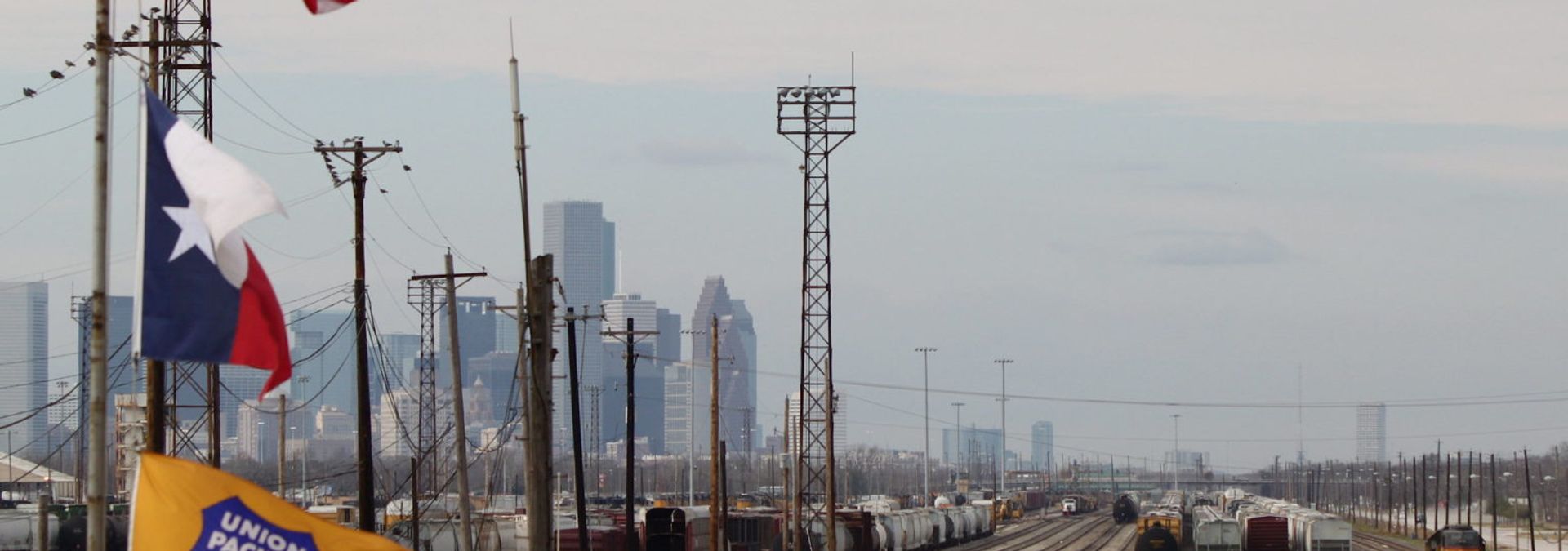
What is a Superfund site?
Houston Mayor Sylvester Turner is urging for the creosote contamination at the Union Pacific Englewood yard to be designated a Superfund site. Photo: Roy Luck. Flickr, Creative Commons License.
Superfund sites are pieces of land or bodies of water that are so contaminated by toxic chemicals that they require long-term attention.
These sites might be where oil refineries, agriculture chemical production operations and other industrial facilities, such as plastic manufacturers, left behind chemicals like chromium, arsenic, benzene and dioxin.
One in six Americans lives within three miles of a Superfund site, according to the Environmental Protection Agency. The health impacts can vary. Women living less than a quarter of a mile away from a Superfund site during the first three months of their pregnancies have been found to be two to four times more likely to give birth to a child with a heart or neural tube defect.
Technically, the U.S. has more than 40,000 Superfund sites, but only a fraction are seen as a “priority” and are managed by the EPA because of all that is required to clean them up. The vast majority of the others are deemed “little” risk. Sometimes, states can receive grants to help them with the cleanup. Sometimes, the sites are redeveloped into subdivisions or strip malls.
In 2019, 1,344 Superfund sites had federal priority — the worst of the worst. In Texas, there are 53 of those — nearly half of which, 21, are in Harris County.
How do Superfund sites impact Houston?
The San Jacinto Waste Pits Superfund site, a former disposal site for waste from paper mills in Channelview, is among Houston region’s most notoriously toxic sites. In 2008, the EPA found dioxin on the site. The chemical has been linked to reproductive and developmental problems, interference with hormone levels, cancer and damage to the immune system.
There’s also the North Cavalde Street Superfund site, the 21-acre home of a former wood treatment company, and the Brio Superfund site in Friendswood. In the 1980s, parents near the Brio site noticed a “sticky, tar-like goo” bubbling up out of the outfield of their children’s Little League baseball diamond. The families would learn that their neighborhood was built by developers on top of the site of several decommissioned chemical refining companies. It was later remediated by the EPA.
What does “remediation” mean? “Essentially, it means that some berm walls, or a tarp or clay covering, might have been put on that site,” says Jackie Young-Medcalf, founder of the Texas Health and Environment Alliance. Young-Medcalf has concentrated on the San Jacinto Superfund site the past decade. For the past three years, she’s also worked on the Jones Road Groundwater Plume Superfund site, where a solvent from a dry cleaner seeped into private water wells, in Harris County.
But even when Superfund sites have been designated as “remediated,” chemicals can still linger. These sites are threatened by climate disasters, which could inundate them with floodwater, damage the berms and coverings and spread the toxic chemicals further. As Young-Medcalf says, “Mother Nature is going to come through and disrupt whichever way she sees fit.”
Houston Mayor Sylvester Turner is now urging for a designation of a 22nd Superfund site in Harris County. In 2019, the Texas Department of State Health confirmed the first of two cancer clusters in Houston’s Fifth Ward and Kashmere Gardens neighborhoods near a railyard owned by Union Pacific where creosote, a cancer-causing chemical, was used for decades to preserve the wooden ties.
Conducted after years of urging from residents, the state’s reports concluded there were higher-than-expected incidences of cancers of the throat, esophagus and lungs in adults and a kind of leukemia in children. The rates of child leukemia are five times higher than the national average.
Getting this area designated as a Superfund site would require Union Pacific to pay for remediation. But the designation alone would not necessarily compel Union Pacific to pay to relocate impacted residents out of harm’s way and financially compensate them for damages; that would require a separate effort, either through the legal system or with the help of local governments. In a statement, Mayor Turner said he is requesting Union Pacific “help to relocate affected residents and create a buffer between contaminated areas and homes in the neighborhood.” In a Houston Public Media report, activists were seen donning shirts reading, “Creosote killed me … and is still killing.”
What can be done?
There’s no one solution to the problem of Superfund sites, because none is the same. Complicating matters more is that the environmental and health impacts will vary according to the levels and the chemicals on site. “If we’re looking at one site, and it has mercury, lead and heavy metals, but it also has hydrocarbons, you’re looking at things people could potentially inhale as well as ingest,” Young-Medcalf says. “What happens to the human body when you basically have a chemical soup — a toxic soup — inside of it?”
But there is one potential solution that could begin to help: taxing polluters to pay to clean up their messes.
The federal Superfund program was enacted in 1980, with the passage of the Comprehensive Environmental Response, Compensation and Liability Act. The idea was to create a “polluter pays” tax, establishing financial liability for companies. The National Priorities List, or NPL, was added in 1983 to help aid a hazard ranking system.
But Congress allowed that tax to lapse in 1995. According to the Center for Health, Environment and Justice, between 1993 and 1995, the tax had created an extra $2 million. But the funds had been depleted by 2003. This same depletion has happened to the EPA’s Superfund program overall. In 1997, there was a balance of $4.7 billion for remediation work. A decade later, that had fallen to $173 million, according to a 2008 report from the U.S. Government Accountability Office.
Advocates say the “polluters pay” tax needs to come back. Jillian Gordner is a campaign associate with U.S. PIRG’s Zero Out Toxics program, working to reinstate the tax in federal Superfund law. She says it’s the most impactful effort right now, and one that won’t fall on the shoulders of ordinary taxpayers. “Right now, the EPA essentially spreads thin a large amount of limited resources in order to keep people happy and show that things are happening at their site,” Gordner says. “It’s not the most efficient way to do things. We need the funding to clean up these sites.”
Peters is freelance writer living in New Orleans. His work has appeared in Scalawag, Rolling Stone, Reason and the Texas Observer. You can find him on Twitter @hipxander.
STAY UP TO DATE
The quality of our newsletter is considered satisfactory and poses little or no risk.
SUBSCRIBE

